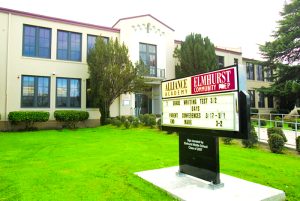Gov. Newsom: California Is Making Progress in Fentanyl Fight

By Magaly Muñoz
The cost of living is growing as millions of California customers will soon start to see the effects of PG&E raising their rates after a case ruling that will hike up monthly utility bills and ultimately raise the cost of living for struggling residents.
The California Public Utilities Commission (CPUC) agreed in November to a request by the electric company for $13.5 billion for wildfire system enhancement and undergrounding, vegetation management, and capacity upgrades.
Starting Jan. 1, residents will see a nearly $33 increase in their upcoming electric and natural gas bill.
Mark Toney, Executive Director of The Utility Reform Network (TURN), an advocacy group, said that low-income families would be most affected by the change.
“I like to say we want the most green for the least green, and the cost of ‘greening the grid’ should not be cutting off low-income families of color from the grid because the monthly bills are too doggone high,” Toney said.
Toney said he was worried that if the cost of utilities continues to increase, some families would be unable to make their payments and would therefore, lose power.
If families choose cost-saving alternatives like using candles, the potential for a fire rises if families with small children accidentally knock something over and don’t put it out in time. People also rely on medical devices for health-related reasons to be hooked up for long periods of time, which could contribute to high costs in electricity bills.
Some Bay Area residents are already struggling to pay their utility bills.
Longtime Oakland resident, Rev. Dr. Barbara Jim-George has found herself using odd, potentially dangerous, alternatives to using her central heat, such as leaving open a hot oven to warm her living room because her apartment is “like a walk-in freezer.”
The CDC has warned against using this method to heat up your home as it can disperse dangerous pollutants and gasses, like carbon monoxide, and worsen already existing lung diseases.
“I can leave something sitting out on my table at night and it’s just fine as it would be in the refrigerator,” Jim-George said.
She had retired from her job in 2014 and was living on a tight budget for a few years until she found herself back at work in 2018 because her social security checks weren’t enough to pay bills.
As the cold and rainy weeks persist, the reverend anticipates a higher utility bill in the mail soon.
Jim-George shared that she had a cousin who lost their home in the Camp Fire of 2018, the deadliest and most destructive wildfire in California’s history, and blamed PG&E for not learning from these tragedies to do what was best for customers.
“They [PG&E] should have buried lines long ago because we’re eating the cost for [their mistakes]. I think it’s negligent on their side to not have had the foresight to understand the issues beforehand,” Jim-George said.
While the reverend is one of many who will have to resort to budgets and taking on second jobs in order to keep up with high housing bills, organizations across the area have seen a large intake of housing and emergency needs for decades, increasing with the effects of the pandemic in the last four years.
The need for utility assistance has grown exponentially, with four times the amount of calls coming in about families who have been without energy or are months behind in bills and are at risk of losing power in their homes.
“Housing [and related needs] remains our top concern for callers calling 211,” Allison DeJung said.
DeJung is the Executive Director of Eden I&R, which operates the calls and messages from 211 Bay Area- a multilingual 24/7 information hotline that connects callers with resources in Alameda County.
She said that in the last fiscal year, her team received over 69,000 calls and they made about 113,000 referrals to programs and organizations in the county for issues related to housing, utilities, food assistance and more.
Prior to the pandemic, less than 2% of callers were asking for utility assistance, but in the last year that percentage has grown to 8.2%, according to Eden I&R data. Oakland made up 40% of the calls to 211, with Black and Latino individuals and single parents making up the majority of the callers. Female callers made up over double that of male callers and most ranged from 25 to 64 years old.
DeJung said most callers looking for help paying their utility services were connected to Spectrum Community Services.
Spectrum is a nonprofit organization that has financially assisted low-income families and individuals through utility, water, and food aid since 1971.
Last year they received nearly 10,000 applications for their Low Income Home Energy Assistance Program (LIHEAP), which helps households pay overdue energy bills. The organization was only able to help 5,000 of those applicants.
Black households, similar to data from Eden I&R, were the majority of applicants for utility assistance at Spectrum, along with the majority of assistance coming from Oakland residents.
Lara Calvert, Executive Director of Spectrum Community Services, said the lack of funding is the primary reason they have to turn away applicants.
Assistance can be granted once every 12 months, with a cap of $3000 in overdue bills. Calvert said the large cap is what also contributes to helping less people every year because if multiple people apply for large quantities of assistance, funding runs out quicker.
Spectrum prioritizes households that have people who are over 60, anybody who’s disabled in the home, people who have children five years or younger, as well as people with a higher overall energy burden for their home.
A high energy burden is when a family’s energy or utility bills take up the majority of a household’s monthly income, making it difficult to maintain a sustainable quality of life.
Calvert shared that although the beginning of the pandemic brought more attention to the organization, 2023 was the largest year for residents asking for assistance from the program and it doesn’t look like it’s going to slow down soon.
“We are anticipating continuing to have a large number of people seeking assistance this year that will far outstrip our amount of money that we have to give out,” Calvert said.





